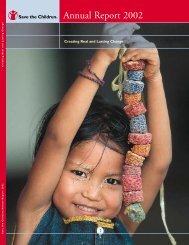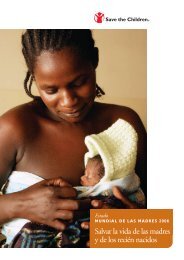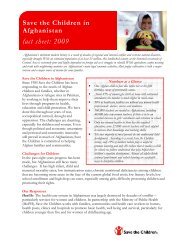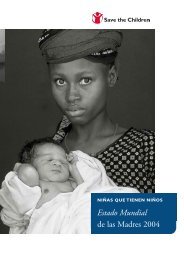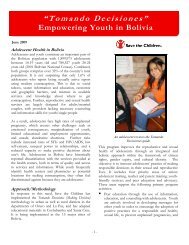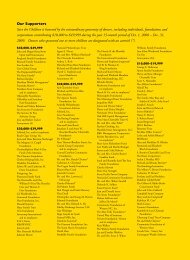Adolescent Sexual and Reproductive Health Toolkit for - UNFPA
Adolescent Sexual and Reproductive Health Toolkit for - UNFPA
Adolescent Sexual and Reproductive Health Toolkit for - UNFPA
You also want an ePaper? Increase the reach of your titles
YUMPU automatically turns print PDFs into web optimized ePapers that Google loves.
ASRH program interventions to link young pregnant<br />
women <strong>and</strong> mothers to maternal <strong>and</strong> newborn health<br />
services during implementation of the MISP include:<br />
• Multi-sector coordination: Coordinate with camp<br />
management, protection <strong>and</strong> community services<br />
sectors to identify pregnant adolescents in the<br />
community. Raise awareness among staff from all<br />
sectors that adolescent pregnancies are a high risk<br />
<strong>for</strong> both the mother <strong>and</strong> the unborn child <strong>and</strong><br />
identify ways to link pregnant adolescents with<br />
maternal <strong>and</strong> newborn health services (clean<br />
delivery packages, facility-based delivery <strong>and</strong><br />
referral services). If necessary, health workers<br />
should link pregnant adolescents to other sectors,<br />
such as protection, <strong>for</strong> additional support.<br />
• <strong>Adolescent</strong>-friendly obstetric services: <strong>Health</strong><br />
providers should underst<strong>and</strong> the health risks<br />
associated with early pregnancy <strong>and</strong> the importance<br />
of providing confidential obstetric services<br />
to adolescents, regardless of their age or marital<br />
status <strong>and</strong> without requiring parental or spousal<br />
consent. <strong>Health</strong> workers should be non-judgmental<br />
<strong>and</strong> should protect the privacy <strong>and</strong> dignity of the<br />
adolescent mother <strong>and</strong> her child. While health<br />
facility delivery should always be encouraged,<br />
pregnant adolescents should be provided with<br />
clean delivery packages, which can be used at the<br />
time of delivery, either in the health facility or<br />
at home. <strong>Adolescent</strong>s should be provided with<br />
in<strong>for</strong>mation <strong>and</strong> access to safe abortion services<br />
when legal.<br />
• Engaging traditional birth attendants or community<br />
health workers: If traditional birth attendants<br />
(TBAs) are already active in the community, they<br />
can serve as links to facility-based services, identifying<br />
pregnant adolescents in the community <strong>and</strong><br />
in<strong>for</strong>ming them about where to seek care if they<br />
experience complications during pregnancy<br />
or childbirth.<br />
• Awareness-raising about services available:<br />
In<strong>for</strong>mation about the risks of adolescent pregnancy<br />
<strong>and</strong> the adolescent-friendly obstetric<br />
services available should be provided during MISP<br />
orientation sessions with adolescent groups, in<br />
schools or other places where adolescents gather.<br />
After the situation has stabilized, other maternal<br />
newborn health interventions can be introduced to<br />
link young pregnant mothers with the health system<br />
<strong>and</strong> to encourage delivery in a health facility. Some<br />
examples include:<br />
• Community-based strategies <strong>for</strong> ante-natal <strong>and</strong><br />
post-partum care (using medical outreach teams<br />
or community health workers) may make those<br />
services more accessible <strong>and</strong> acceptable to adolescents.<br />
Community-based workers can identify<br />
young pregnant mothers <strong>and</strong> link them to<br />
appropriate health services.<br />
• TBAs <strong>and</strong> pregnant adolescents should be<br />
educated about the importance of skilled birth<br />
attendance at delivery. <strong>Adolescent</strong>s may be<br />
more likely to deliver in a health facility with<br />
skilled attendants if they are accompanied by<br />
someone whom they trust. TBAs should be<br />
taught the danger signs of pregnancy, labor<br />
<strong>and</strong> delivery so that if an adolescent develops<br />
a complication during pregnancy or home<br />
delivery, the TBA knows to refer her to the<br />
health facility immediately.<br />
• Birth plans should be developed with young<br />
mothers, their partners <strong>and</strong> their families to avoid<br />
unnecessary delays in seeking medical attention<br />
when they go into labor.<br />
• Maternity waiting homes located near health facilities<br />
provide women with a safe place to stay during the<br />
final weeks of their pregnancies. Establishing<br />
maternity waiting homes <strong>and</strong> making them available<br />
to adolescent mothers may help ensure that<br />
these high-risk mothers deliver in EmONC facilities.<br />
• Family planning options should be discussed with<br />
young mothers during pregnancy <strong>and</strong> again at the<br />
post-partum visit; <strong>and</strong> referral should be made <strong>for</strong><br />
FP services, if desired.<br />
• Breastfeeding support should be provided to ensure<br />
that adolescents use proper feeding practices <strong>and</strong><br />
infants receive optimal nutrition.<br />
• Infant care support groups should be established to<br />
help adolescent mothers take care of their babies.<br />
• Mental health <strong>and</strong> psychosocial support must<br />
be integrated into maternal <strong>and</strong> newborn<br />
health services.<br />
• Education programs should be supported so that<br />
adolescent mothers can continue with their education.<br />
34<br />
<strong>Adolescent</strong> <strong>Sexual</strong> <strong>and</strong> <strong>Reproductive</strong> <strong>Health</strong> <strong>Toolkit</strong> <strong>for</strong> Humanitarian Settings




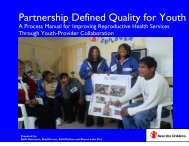

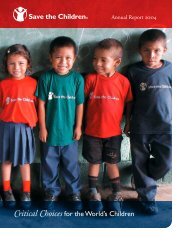
![View full document [PDF 3.39 MB] - PreventionWeb](https://img.yumpu.com/27308954/1/190x245/view-full-document-pdf-339-mb-preventionweb.jpg?quality=85)
